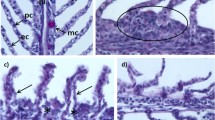Abstract
Serial observations of DDT-contaminated and uncontaminated salt marshes in the northern Gulf of Mexico were made in November and December, 1973. Blue crab (Callinectes sapidus) mortalities observed in the DDT-contaminated marsh during this period were correlated with reduced daily temperature minima. Gas chromatographic analysis of hepatopancreas and swimmeret muscle tissue of dead and dying crabs revealed total DDT residue concentrations as high as 39.0 ppm and 1.43 ppm, respectively. It is suggested that the DDT body burdens and reduced temperatures interact to produce acutely toxic effects. Several physiological and behavioral mechanisms are proposed.
Similar content being viewed by others
References
Anderson, J. M.: Assessment of the effects of pollutants on physiology and behavior. Proc. Roy. Soc. Lond. B.177, 307 (1971).
Butler, P. A.: Commercial fishery investigations, p. 65–77. In Effects of pesticides on fish and wildlife. U. S. Fish and Wildlife Serv., Circ. No. 226 (1965).
Butler, P. A.: The significance of DDT residues in estuarine fauna, p. 205–220. In M. W. Miller and G. G. Berg (eds.) Chemical fallout: Current research on persistent pesticides. Illinois: C. C. Thomas Company (1969).
Butler, P. A., and P. F. Springer: Pesticides — a new factor in coastal environments. Trans. 28th N. Amer. Wildlife Nat. Res. Conf., p. 378–390 (1963).
Carriker, M. R.: Ecology of estuarine benthic invertebrates: A perspective, p. 442–487. In G. H. Lauff (ed.) Estuaries. Amer. Assoc. Adv. Sci., Publ. No. 83 (1967).
Commercial Fisheries Review DDT. Commercial Fisheries Review8, 30 (1946).
Cottom, C., and E. Higgins: DDT: its effects on fish and wildlife. U. S. Fish and Wildlf. Serv., Circular No. 11, 14 p. (1946).
Darnell, R. M.: Studies of the life history of the blue crab (Callinectes sapidus) in Louisiana waters. Trans. Amer. Fish. Soc.88, 294 (1959).
Holan, G.: New halocyclopropane insecticides and the mode of action of DDT. Nature221, 1025 (1969).
Lowe, J. I.: Chronic exposure of blue crabs,Callinectes sapidus, to sublethal concentrations of DDT. Ecology46, 900 (1965).
Manhood, R. K., M. D. McKenzie, D. P. Middaugh, S. J. Bollar, J. R. Davis, and D. Spitzbergen: A report on the cooperative blue crab study — South Atlantic states. U. S. Dept. Interior, B.C.F. 32 p (1970).
Mills, H. R.: Deaths in Florida marshes. Audubon54, 285 (1952).
O'Brien, R. D.: Insecticides action and metabolism. New York: Academic Press, 332 p (1967).
Odum, W. E.: Insidious alteration of the estuarine environment. Trans. Amer. Fish. Soc.99, 836 (1970).
Odum, W. E., G. M. Woodwell, and C. F. Wurster: DDT residue adsorbed from organic detritus by fiddler crabs. Science164, 576 (1969).
Peterson, R. H.: Temperature selection of Atlantic salmon (Salmo salar) and brook trout (Salvelinus fontinalis) as influenced by various chlorinated hydrocarbons. J. Fish. Res. Bd. Can.30, 1091 (1973).
Pyle, R. W., and L. F. Cronin: The general anatomy of the blue crab,Callinectes sapidus. Chesapeake Biological Laboratory, Solomons, Md., Publ. No. 87, 40 p (1950).
Springer, P. F., and J. R. Webster: Biological effects of DDT applications on tidal salt marshes. Mosquito News11, 67 (1951).
Thompson, N. P., P. W. Rankin, and D. W. Johnston: Polychlorinated biphenyls andp,p′-DDE in green turtle eggs from Ascension Island South Atlantic Ocean. Bull. Environ. Contamin. Toxicol.11, 399 (1974).
Woodwell, G. M., C. F. Wurster, and P. A. Isaacson: DDT residues in an east coast estuary: a case of biological concentration of a persistent insecticide. Science156, 821 (1967).
Woodwell, G. M., P. P. Craig, and H. A. Johnson: DDT in the biosphere: Where does it go? Science174, 1101 (1971).
Author information
Authors and Affiliations
Rights and permissions
About this article
Cite this article
Koenig, C.C., Livingston, R.J. & Cripe, C.R. Blue crab mortality: Interaction of temperature and DDT residues. Arch. Environ. Contam. Toxicol. 4, 119–128 (1976). https://doi.org/10.1007/BF02221017
Received:
Accepted:
Issue Date:
DOI: https://doi.org/10.1007/BF02221017




